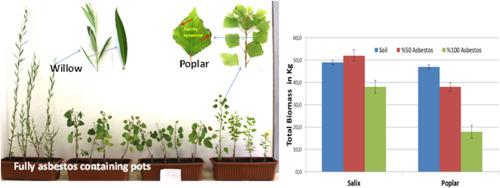Remediation of asbestos with poplar and willow species and gene regulation network behind asbestos toxicity tolerance in trees
IF 8.1
2区 环境科学与生态学
Q1 ENVIRONMENTAL SCIENCES
引用次数: 0
Abstract
Asbestos is a naturally occurring fibrous silicate mineral commonly used in many industries. Due to the definite link between asbestos exposure and lung carcinoma, production and utilization of asbestos have been banned in many countries. Although this ban reduces the possibility of occupational exposure of humans to asbestos, it is reported that asbestos exposure from natural sources is at a very high level in some parts of the world, including Turkey. Therefore, the afforestation of asbestos mines and natural sources is highly important for human health. In the current study, poplar and willow species collected in an asbestos-contaminated Turkish village were grown under asbestos-contaminated soils and tested for their tolerance to asbestos toxicity. The SEM, XRD and elemental analysis revealed that asbestos-contaminated soil rich in metals (Mg, Fe, Al, Cr, Ni, Co) and accumulation of these metals in the leaves and roots of the plants is the main reason for the asbestos toxicity in the trees. Deficiencies of plant nutritional minerals (K, B, Na) in asbestos also caused less tree growth in these contaminated soils. Elemental analysis on the plant tissues indicated that willow species grown in asbestos-contaminated soils accumulated threefold fewer asbestos metals and performed more biomass growth than poplars. Microarray-based transcriptome analysis on the asbestos-treated leaves and roots of trees revealed upregulation of genes functional in metal detoxification in poplar and Salicycilc acid-regulated toxicity tolerance in willow. Transcripts functional in ROS scavenging, enzymes/protein protection, and metal chelating are the most strongly upregulated genes in response to asbestos toxicity in poplar and willow tissues. ABC transporters, Heavy metal-associated isoprenylated plant protein, Glutathione S-transferases, and Glucosyltransferases represented much higher gene expression in asbestos-treated poplars than willow. Expressions of these genes were associated with the uptake of excess asbestos metals, their translocation to the leave, and cellular detoxification in poplar. On the other hand, asbestos-treated willow leaves and roots differentially induced the expression of the genes functional in salicylic acid (SA) biosynthesis and SA acid-regulated genes (Kunitz type protease inhibitors, pathogenesis-related genes and chitinases, etc). This SA-mediated gene regulation in willow tissues was linked to lower accumulation of asbestos-related metals and higher tolerance to asbestos toxicity in trees for the first time.

杨树和柳树对石棉的修复及其耐石棉基因调控网络。
石棉是一种天然存在的纤维硅酸盐矿物,通常用于许多工业。由于石棉暴露与肺癌之间的明确联系,石棉的生产和利用已在许多国家被禁止。尽管这一禁令减少了人类职业接触石棉的可能性,但据报道,在世界某些地区,包括土耳其,来自天然来源的石棉接触水平非常高。因此,石棉矿山和天然资源的造林对人体健康至关重要。在目前的研究中,在一个石棉污染的土耳其村庄收集的杨树和柳树物种在石棉污染的土壤下生长,并测试了它们对石棉毒性的耐受性。SEM、XRD和元素分析表明,石棉污染土壤中含有丰富的金属(Mg、Fe、Al、Cr、Ni、Co),这些金属在植物的叶片和根系中积累是造成树木石棉毒性的主要原因。石棉中缺乏植物营养矿物质(K, B, Na)也导致这些污染土壤中树木生长减少。植物组织元素分析表明,在石棉污染土壤中生长的柳树积累的石棉金属比杨树少3倍,生物量比杨树多。对石棉处理过的树木叶片和根系的转录组分析显示,杨树金属解毒功能基因上调,柳树水杨酸调节的毒性耐受基因上调。在杨树和柳树组织中,具有活性氧清除、酶/蛋白保护和金属螯合功能的转录本是对石棉毒性反应中表达最强烈的基因。ABC转运蛋白、重金属相关异丙烯酰化植物蛋白、谷胱甘肽s-转移酶和葡萄糖基转移酶在石棉处理杨树中的基因表达高于柳树。这些基因的表达与杨树对过量石棉金属的吸收、向叶片的转运和细胞解毒有关。另一方面,石棉处理柳叶和柳根诱导水杨酸(SA)生物合成功能基因和SA酸调控基因(Kunitz型蛋白酶抑制剂、发病相关基因和几丁质酶等)的表达存在差异。柳树组织中sa介导的基因调控首次与降低石棉相关金属的积累和提高树木对石棉毒性的耐受性有关。
本文章由计算机程序翻译,如有差异,请以英文原文为准。
求助全文
约1分钟内获得全文
求助全文
来源期刊

Chemosphere
环境科学-环境科学
CiteScore
15.80
自引率
8.00%
发文量
4975
审稿时长
3.4 months
期刊介绍:
Chemosphere, being an international multidisciplinary journal, is dedicated to publishing original communications and review articles on chemicals in the environment. The scope covers a wide range of topics, including the identification, quantification, behavior, fate, toxicology, treatment, and remediation of chemicals in the bio-, hydro-, litho-, and atmosphere, ensuring the broad dissemination of research in this field.
 求助内容:
求助内容: 应助结果提醒方式:
应助结果提醒方式:


